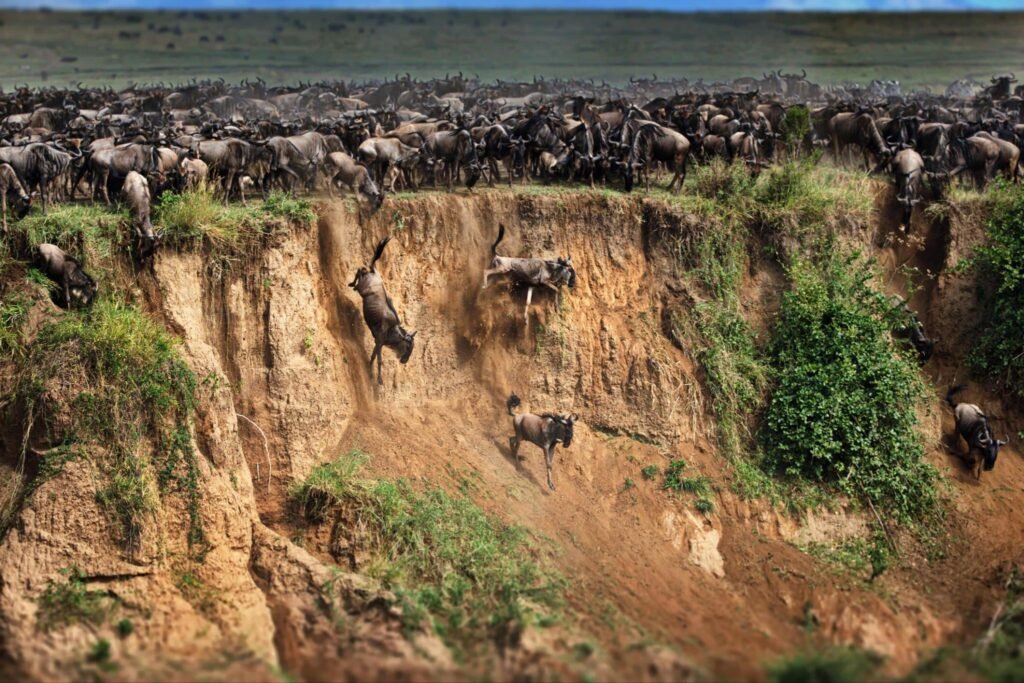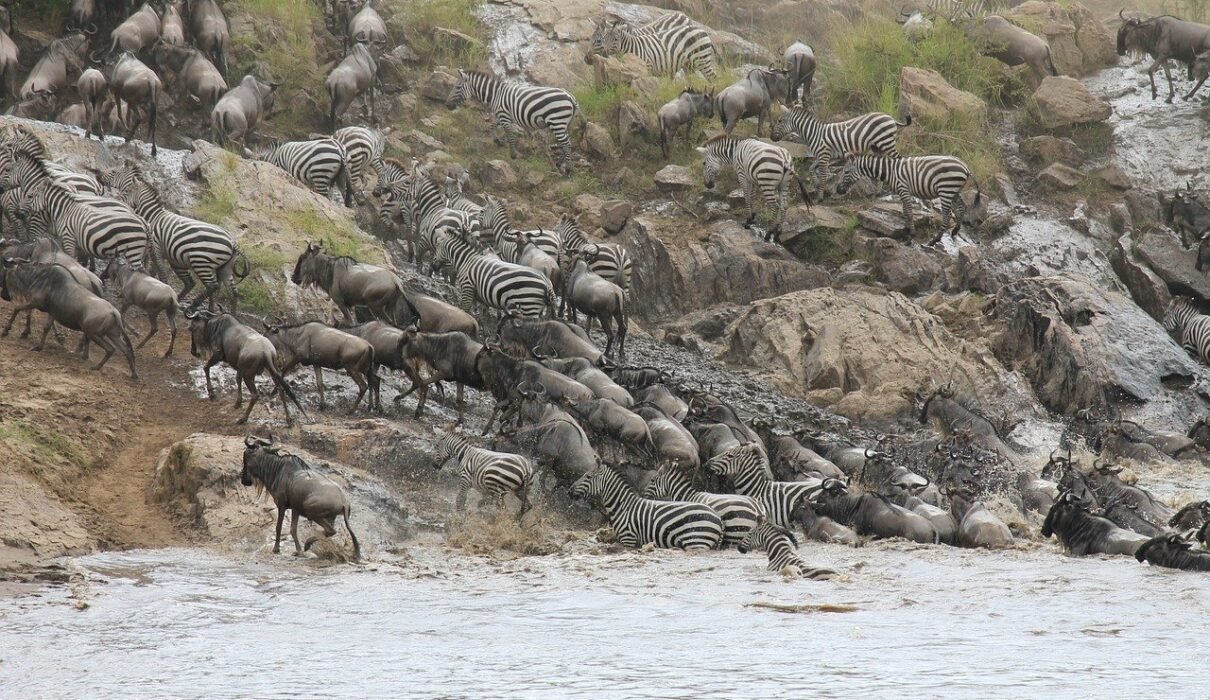Fascinating Facts About the Blue Wildebeest : The blue wildebeest (also known as the gnu) is one of Africa’s most iconic animals, playing a key role in the ecosystems of savannahs and grasslands. Known for their massive annual migration across East Africa, wildebeest herds create one of the most spectacular wildlife events in the world. Here are some fascinating facts about the blue wildebeest that highlight their unique behavior, survival strategies, and role in maintaining Africa’s biodiversity.
Learn more about African wildlife and safari experiences.

Fascinating Facts About the Blue Wildebeest : Blue Wildebeest Are Famous for the Great Migration
The Great Migration is one of the most extraordinary wildlife events on the planet, with more than 1.5 million wildebeest moving across the plains of the Serengeti in Tanzania and the Maasai Mara in Kenya. Along with zebras and gazelles, the wildebeest migrate in search of fresh grazing lands, following the seasonal rains.
- Distance Covered: The migration spans over 1,800 miles, making it one of the longest land migrations in the world.
- Key River Crossings: Wildebeest face perilous river crossings, especially at the Mara River, where crocodiles await.
Discover more about the Great Migration.
Fascinating Facts About the Blue Wildebeest : They’re Built for Long-Distance Travel
Blue wildebeest are perfectly adapted for the long journeys they undertake during the migration. Their muscular bodies and sturdy legs allow them to travel long distances with minimal energy, while their unique hooves help them navigate varied terrains, from grassy plains to muddy rivers.
- Speed: Wildebeest can run at speeds of up to 50 miles per hour to escape predators.
- Herd Defense: Moving in large herds helps protect them from predators like lions, hyenas, and crocodiles.
Learn more about how wildebeest move in herds.
Fascinating Facts About the Blue Wildebeest : Blue Wildebeest Calving Season Is Synchronized
One of the most interesting aspects of blue wildebeest behavior is their synchronized calving. During a brief period of about three weeks, almost all wildebeest calves are born—roughly 500,000 calves. This overwhelms predators, increasing the chances of survival for the newborns.
- Why It’s Important: Synchronized births ensure that enough calves survive, as predators like lions and cheetahs can only catch so many at a time.
- Fast Development: Newborn calves can stand and run within minutes of being born, making them less vulnerable to predators.
Read about wildebeest calving season.
Wildebeest Are Essential to Africa’s Grassland Ecosystems
Blue wildebeest play a critical role in maintaining the health of African grasslands. As they graze, they help fertilize the soil with their droppings, which promotes the growth of new vegetation. This, in turn, supports a wide range of species, including herbivores and predators.
- Grazing Patterns: Their grazing helps maintain grassland ecosystems, preventing overgrowth and encouraging biodiversity.
- Food Chain: Wildebeest are a key food source for major predators such as lions, cheetahs, and hyenas.
Learn more about the wildebeest’s role in the ecosystem.
Fascinating Facts About the Blue Wildebeest : Blue Wildebeest Communicate Through Sound and Smell
Wildebeest are highly social animals, and they communicate with one another using a variety of sounds, including grunts and snorts. They also use scent markings to define territory and recognize members of their herd.
- Vocalizations: Their distinctive grunting sounds help the herd stay together during the migration.
- Scent Marking: Glands located near their eyes and feet release scents to communicate territory boundaries and herd membership.
Explore more about wildebeest communication.
They’re Surprisingly Agile and Fast
Although blue wildebeest may appear slow or clumsy when grazing, they are incredibly agile and fast when threatened by predators. Their long legs allow them to gallop at high speeds and make sharp turns, which helps them evade hunters like lions and cheetahs.
- Top Speed: Wildebeest can reach speeds of up to 50 miles per hour when fleeing from danger.
- Zigzagging: When chased, they often run in a zigzag pattern to confuse predators and make it harder for them to catch up.
Learn how wildebeest escape predators.
7Fascinating Facts About the Blue Wildebeest : Wildebeest Have a Lifespan of Around 20 Years
In the wild, blue wildebeest typically live for around 20 years, although life expectancy can vary depending on environmental conditions and predation. Those that survive the hazards of migration and predation can enjoy relatively long lives compared to other herbivores.
- Diet: Wildebeest feed primarily on short grasses, which provide them with the nutrients needed for their long migrations.
- Predators: Despite their large numbers, many wildebeest fall prey to lions, leopards, and hyenas throughout their lifetime.
Read about the lifespan of wildebeest in the wild.
Fascinating Facts About the Blue Wildebeest : They Can Smell Rain from Miles Away
One of the most fascinating facts about blue wildebeest is their ability to sense rain from miles away. This instinct helps guide their migration as they follow the rains to find fresh grazing areas. Wildebeest herds are often seen heading towards storm clouds, knowing that the rains will provide the lush grass they need to survive.
- Rain Detection: Their incredible sense of smell helps them navigate vast distances in search of water and food.
- Migratory Behavior: Wildebeest rely on this instinct to stay one step ahead of the dry season.
Discover how wildebeest use their senses for survival.
Blue Wildebeest Are Known for Their Odd-Looking Appearance
With their humped shoulders, long faces, and thin legs, blue wildebeest have a unique and somewhat comical appearance. Despite their heavy build, they’re incredibly agile and fast runners. Their characteristic grayish-blue coats, which give them their name, and shaggy manes make them easily recognizable on the savannah.
- Distinctive Features: Their unusual body shape and facial features make them one of Africa’s most recognizable animals.
- Male vs. Female: Males are typically larger and have darker, thicker manes compared to females.
Learn more about the physical traits of wildebeest.
Fascinating Facts About the Blue Wildebeest : Blue Wildebeest Are Not Endangered
Despite the challenges of migration, habitat loss, and predation, the blue wildebeest population remains healthy. Thanks to protected areas like the Serengeti National Park and the Maasai Mara, their numbers have been sustained. Conservation efforts continue to protect these unique animals and the ecosystems they rely on.
- Population Status: Currently, blue wildebeest are listed as “Least Concern” by the IUCN.
- Conservation Areas: Many of Africa’s national parks are focused on preserving the habitats that wildebeest and other migratory animals depend on.
Read more about the conservation status of blue wildebeest.

Fascinating Facts About the Blue Wildebeest : Conclusion
The blue wildebeest is a remarkable species that plays a crucial role in Africa’s savannah ecosystems. Their massive migrations sustain a delicate balance in the food chain and help support diverse habitats across East Africa. Learning about their behaviors and survival strategies gives us a greater appreciation for these unique animals and the natural environments they help maintain.
To witness the great migration and experience the beauty of the blue wildebeest firsthand, check out Kilimanjaro Climb Specialist or Eddy Tours & Safaris.

